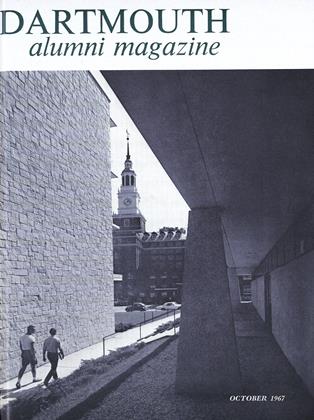THE CHICAGO SCHOOL OF ARCHITECTURE, EARLY FOLLOWERS OF SULLIVAN AND WRIGHT.
OCTOBER 1967 H.H. GIBSON JR. '26THE CHICAGO SCHOOL OF ARCHITECTURE, EARLY FOLLOWERS OF SULLIVAN AND WRIGHT. H.H. GIBSON JR. '26 OCTOBER 1967
By MarkL. Peisch '44. New York: Random House,1964. 177 pp. Cloth, $4.95. Paper, $2.95.
The "Chicago School of Architecture" is generally acknowledged to have been our most interesting regional group, primarily because two great architects, Louis Sullivan and Frank Lloyd Wright, designed important work there and early in their careers achieved international influence and acclaim. Mark Peisch, while noting the preeminence of this pair, has chosen to deal with many lesser known contemporaries and to range over a wide area of building activity, including suburban development and town planning.
In an early chapter Peisch discusses the inceptions of architectural education in the Midwest and points up the pioneering influence of Nathan Ricker, Dean of the School of Architecture, University of Illinois. Succeeding chapters survey the architectural situation in Chicago around 1900, the impact of the 1893 Fair, the originative power of Wright's Oak Park Studio (1900-1909) and the residential work designed there. Later sections of the book give a detailed tally of the "School's" variety in domestic architecture, public buildings of all types, and civic planning.
The main protagonist of Peisch's study is Walter Burley Griffin (1876-1937), architect, site designer, and city planner. Griffin studied under Ricker at Illinois; he joined Wright's atelier in Oak Park on a full-time basis in 1902; in 1912 he won the international competition for the design of Canberra, the new Australian capital; and in 1913 he left for Australia to supervise his plan, and never resumed professional practice in this country. Peisch describes in detail Griffin's more important commissions, including Rock Glen, a private community in Mason City, Iowa; the New Trier Neighborhood, Winnetka, Ill.: and the Canberra project, to which an entire chapter is given. He has also provided a number of interesing photographs of Griffin's work, many of which are published in book form for the first time.
As a lingering influence on American design during the 1920's the "Chicago School" all but disappeared in a welter of eclecticism: Sullivan died in 1925; Wright established himself elsewhere, and had few commissions; and, as Peisch comments, "the tide of taste turned strongly against them." But the author knows that it was an exciting and protean group; and he has written a carefully documented account, sympathetically and well.
Mr. Gibson, who attended the HarvardGraduate School of Architecture, worked inChicago architectural offices 1928-1933.
 View Full Issue
View Full Issue
More From This Issue
-
 Feature
FeatureMore Dividends Than Expected
October 1967 By MARION BLYTH -
 Feature
FeatureThird Century Fund Leaders ...
October 1967 -
 Feature
FeatureHalsey Charles Edgerton '06
October 1967 -
 Feature
Feature$51 Million Goal of Third Century
October 1967 -
 Article
ArticleThe Faculty
October 1967 -
 Article
ArticleWith the Big Green Teams
October 1967
Books
-
 Books
BooksHerbert L. Searles '17
June 1947 -
 Books
BooksAPOLLINAIRE: POET AMONG THE PAINTERS
MARCH 1964 By GEORGE E. DILLER -
 Books
BooksFRESH AIR, BRIGHT WATER: ADVENTURES IN WOOD, FIELD, AND STREAM.
JULY 1971 By JAMES L FARLEY '42 -
 Books
BooksPREPARATION FOR CHILDBIRTH: A LAMAZE GUIDE.
OCTOBER 1971 By JOHN S. LYLE '34, M.D. -
 Books
BooksTHE LETTERS OF ROBERT FROST TO LOUIS UNTERMEYER.
JANUARY 1964 By STEARNS MORSE -
 Books
BooksHISTORY OF WARREN COUNTY, NEW YORK.
JANUARY 1964 By W. RANDALL WATERMAN


